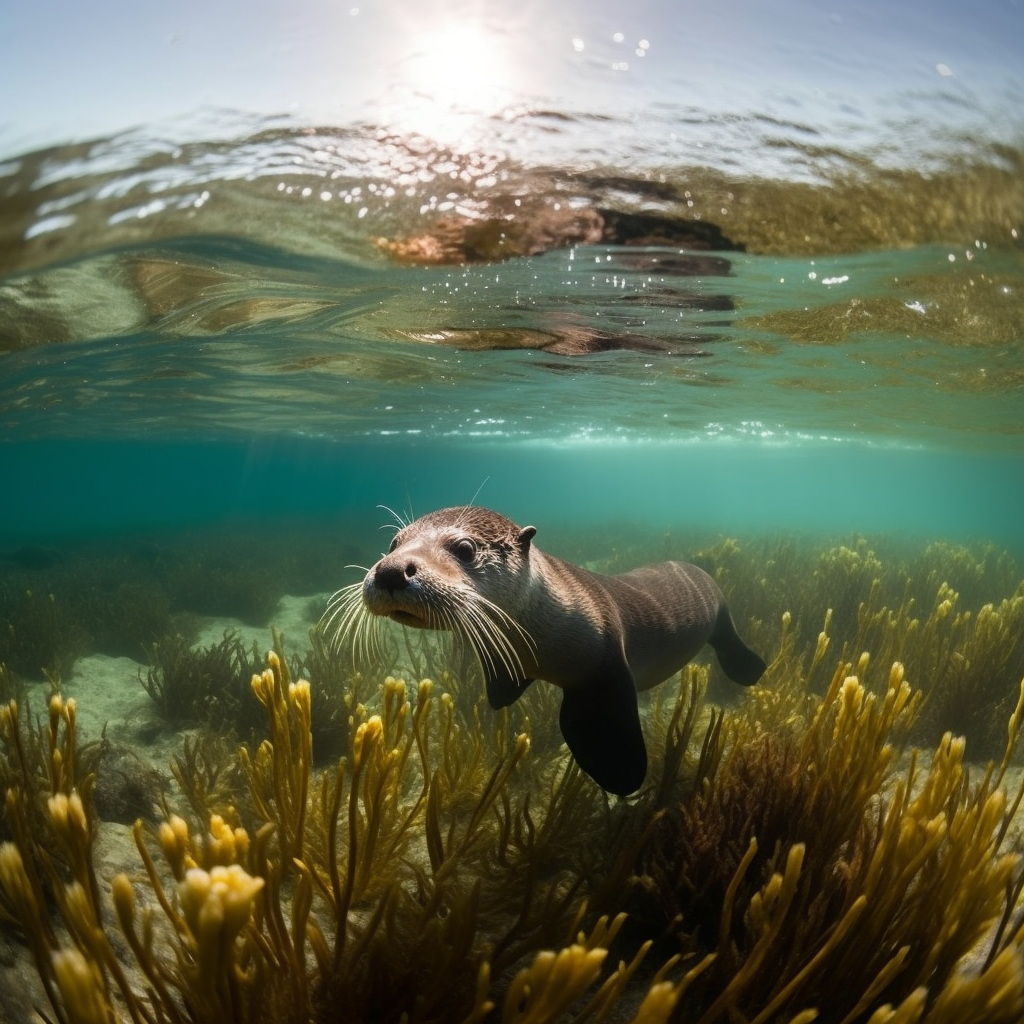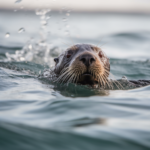Can River Otters Live In Saltwater?
River otters are fascinating creatures known for their playful behavior and sleek, streamlined bodies. Found in various habitats across North America, these semi-aquatic mammals are well-adapted to living in freshwater environments such as rivers, lakes, and marshes. However, when it comes to saltwater, the question arises: can river otters survive in such an environment? In this article, we will explore the adaptability of river otters to saltwater habitats and delve into the factors that influence their ability to thrive in these challenging conditions. So, let’s dive in and discover whether river otters can truly call the salty seas their home.
Key Takeaways
- River otters are primarily found in freshwater habitats and are not well adapted to live in saltwater.
- While river otters can tolerate brackish water for short periods, they cannot survive in full-strength saltwater.
- Saltwater is detrimental to the otters’ fur and can cause dehydration and other health issues.
- River otters rely on freshwater ecosystems for their survival, including for finding food and building dens. Understanding River Otters: A Brief Overview
A. What are River Otters?
River otters are fascinating creatures that belong to the Mustelidae family, which also includes weasels, badgers, and minks. These semi-aquatic mammals are known for their playful nature and sleek, streamlined bodies that allow them to navigate through water with ease. River otters have long, muscular tails, webbed feet, and dense fur that helps to keep them warm in cold water.
These intelligent creatures are highly adaptable and can be found in a variety of habitats, including rivers, lakes, marshes, and estuaries. They are excellent swimmers, capable of diving underwater for several minutes in search of food. River otters are carnivorous and primarily feed on fish, amphibians, crustaceans, and small mammals.
B. The Habitat of River Otters
River otters are primarily found in freshwater environments, such as rivers and lakes. They are well-suited to these habitats, as their streamlined bodies and webbed feet allow them to swim swiftly and gracefully through the water. However, river otters are not limited to freshwater habitats alone.
While they are not typically found in saltwater environments, river otters have been known to venture into estuaries, where freshwater and saltwater mix. Estuaries provide a unique habitat for these creatures, as they offer a diverse range of food sources and shelter. In estuaries, river otters can find an abundance of fish, crustaceans, and other small marine creatures to sustain themselves.
It’s important to note that river otters are different from sea otters, which are specifically adapted to live in saltwater environments. Sea otters have a layer of insulating blubber and a specialized coat that helps them stay buoyant in the ocean. River otters, on the other hand, lack these adaptations and are not as well-equipped to survive in saltwater.
In conclusion, while river otters primarily inhabit freshwater environments, they can occasionally be found in estuaries where freshwater and saltwater mix. However, they are not adapted to live in saltwater environments like sea otters. The unique adaptations of river otters make them fascinating creatures to study and appreciate in their natural habitats.
The Saltwater Habitat: Can River Otters Survive?

A. The Physiology of River Otters: Adaptation to Saltwater
River otters are fascinating creatures known for their playful behavior and sleek bodies. While they are primarily found in freshwater habitats such as rivers, lakes, and marshes, there have been instances where river otters have been observed in saltwater environments. This raises the question: can river otters survive in saltwater?
River otters have evolved to be well-adapted to their freshwater habitats, but they do possess certain physiological characteristics that enable them to tolerate some level of salinity. Unlike their close relatives, sea otters, river otters do not have the same level of saltwater adaptation. Sea otters have specialized glands that help them remove excess salt from their bodies, allowing them to thrive in marine environments. River otters, on the other hand, lack these glands and are not as well-equipped to handle high levels of salinity.
B. Saltwater vs Freshwater: The Impact on River Otters’ Health
While river otters may be able to tolerate some exposure to saltwater, prolonged exposure can have negative effects on their health. The high salt content in seawater can dehydrate river otters and disrupt their electrolyte balance, leading to dehydration and potentially even death. Additionally, the saltwater can irritate their skin and eyes, causing discomfort and potential infections.
Freshwater is essential for river otters as it helps regulate their body temperature, aids in digestion, and provides a source of hydration. Their bodies have adapted to efficiently process and retain freshwater, making it crucial for their overall well-being. Therefore, while river otters may occasionally venture into saltwater environments, their health and survival ultimately depend on access to freshwater habitats.
C. The Diet of River Otters in Saltwater
The diet of river otters primarily consists of fish, amphibians, crustaceans, and other small aquatic creatures. In freshwater habitats, they have a diverse range of prey to choose from. However, in saltwater environments, their options become more limited. The availability of their preferred prey, such as freshwater fish, may be scarce in saltwater habitats.
River otters are opportunistic feeders and can adapt their diet to some extent. In saltwater, they may consume marine fish and invertebrates that are more tolerant of salinity. However, these alternative food sources may not provide the same nutritional value as their freshwater counterparts. This can impact the overall health and reproductive success of river otters in saltwater environments.
In conclusion, while river otters may have some tolerance for saltwater, their physiological adaptations and dietary preferences make them better suited for freshwater habitats. Prolonged exposure to saltwater can have detrimental effects on their health, and the availability of suitable prey may be limited. Therefore, it is unlikely for river otters to thrive in saltwater environments, and their survival depends on the availability of freshwater habitats.
Case Studies: River Otters Living in Saltwater Environments

A. River Otters in Coastal Regions
River otters are primarily known for their presence in freshwater habitats such as rivers, lakes, and marshes. However, there have been several interesting case studies that highlight the adaptability of river otters to coastal regions and their ability to thrive in saltwater environments.
One such case study took place in the Pacific Northwest, where river otters were observed living along the coastlines and estuaries. These otters displayed remarkable swimming abilities, allowing them to navigate the dynamic and often turbulent waters of the ocean. They were frequently spotted hunting for fish, crabs, and other marine creatures, showcasing their versatility in adapting to new food sources.
Another study conducted in California revealed the presence of river otters in saltwater habitats such as brackish marshes and tidal creeks. These otters were observed swimming effortlessly in the salty waters, indicating their ability to tolerate higher salinity levels. The study also found that these coastal river otters had a diverse diet, including marine invertebrates and even small marine mammals.
B. Survival Strategies of River Otters in Saltwater
River otters have evolved several survival strategies that enable them to thrive in saltwater environments. These strategies help them overcome the challenges posed by the higher salinity levels and the unique characteristics of marine habitats.
-
Saltwater Adaptation: River otters have developed physiological adaptations that allow them to tolerate higher salinity levels. Their kidneys are efficient at conserving water and excreting concentrated urine, which helps them maintain proper hydration in saltwater environments.
-
Dietary Flexibility: River otters in saltwater regions have shown remarkable dietary flexibility. While their primary diet consists of fish, they have been observed consuming a wide range of marine organisms, including crustaceans, mollusks, and even seabirds. This adaptability allows them to exploit the available food sources in their coastal habitats.
-
Swimming and Diving Skills: River otters are excellent swimmers and divers, which is crucial for their survival in saltwater environments. Their streamlined bodies, webbed feet, and strong tails enable them to navigate through the water with agility and speed. They can dive to considerable depths to catch prey and stay submerged for extended periods.
-
Social Behavior: River otters are highly social animals, often living in family groups called “rafts.” This social structure provides them with protection and support in saltwater environments. By staying together, they can defend against potential predators and share information about food sources and potential dangers.
In conclusion, while river otters are primarily associated with freshwater habitats, they have demonstrated their ability to adapt and thrive in saltwater environments. Case studies have shown their presence in coastal regions, where they display remarkable swimming abilities, adapt their diet, and employ various survival strategies. These findings highlight the resilience and adaptability of river otters, showcasing their ability to explore and colonize diverse habitats.
The Impact of Saltwater on River Otters’ Behavior and Lifestyle

A. Social Structure and Behavior of River Otters in Saltwater
River otters are highly adaptable creatures that are primarily found in freshwater habitats such as rivers, lakes, and wetlands. However, they are also known to venture into saltwater environments, particularly in estuaries where freshwater and saltwater mix. While river otters are not specifically adapted to live in saltwater, they can tolerate some level of salinity.
In saltwater environments, river otters exhibit certain behavioral and social adaptations to cope with the challenges posed by the higher salinity. Here are some key aspects of their behavior and social structure in saltwater:
-
Foraging Behavior: River otters in saltwater environments primarily feed on marine fish, crustaceans, and mollusks. They are skilled hunters and use their acute sense of smell and dexterity to locate and capture their prey. They are known to dive and swim underwater for extended periods, often covering long distances in search of food.
-
Territoriality: River otters in saltwater habitats may establish territories along the shoreline or in specific areas with abundant food resources. These territories can overlap with those of other otters, leading to occasional conflicts. However, river otters are generally social animals and may form loose associations with other otters, particularly during the breeding season.
-
Communication: River otters use a variety of vocalizations, including chirps, whistles, and growls, to communicate with each other. These vocalizations help them maintain contact, establish dominance, and warn others of potential threats. They also use scent marking, such as sprainting (leaving droppings), to communicate their presence and territorial boundaries.
-
Reproduction: River otters in saltwater environments follow a similar reproductive pattern as their freshwater counterparts. Breeding typically occurs in late winter or early spring, and females give birth to a litter of 1 to 6 pups. The female otter raises the young, while the male may provide some assistance in protecting the territory.
B. Reproduction and Lifespan of River Otters in Saltwater
The reproduction and lifespan of river otters in saltwater environments are influenced by various factors, including food availability, habitat quality, and predation pressure. Here’s what you need to know about their reproduction and lifespan in saltwater:
-
Breeding Season: River otters in saltwater habitats generally follow the same breeding season as their freshwater counterparts. Breeding typically occurs in late winter or early spring when food resources are abundant. During this time, male otters may compete for access to females, engaging in playful but sometimes aggressive behaviors.
-
Gestation and Birth: After a gestation period of around 60 to 63 days, female otters give birth to their pups in a den located near the water’s edge. The den provides protection and shelter for the vulnerable young. The female otter takes on the primary responsibility of caring for the pups, nursing them and teaching them essential survival skills.
-
Lifespan: The lifespan of river otters in saltwater environments can vary depending on various factors. In general, river otters have a lifespan of 10 to 15 years in the wild, although some individuals have been known to live longer. Factors such as predation, disease, and habitat degradation can impact their lifespan.
-
Parental Care: River otters in saltwater environments exhibit strong parental care. The female otter is the primary caregiver, providing nourishment and protection to the young. The pups are born with a dense coat of fur, which helps them stay buoyant in the water. As they grow, the mother teaches them essential skills such as swimming, diving, and hunting.
In conclusion, while river otters are primarily adapted to freshwater habitats, they can tolerate some level of salinity and venture into saltwater environments. In these saltwater habitats, river otters exhibit unique behavioral and social adaptations to cope with the challenges posed by the higher salinity. Understanding their behavior and reproductive patterns in saltwater can provide valuable insights into their overall lifestyle and survival strategies.
Conservation Efforts for River Otters in Saltwater Habitats
A. Threats to River Otters in Saltwater Environments
River otters are primarily known for their ability to thrive in freshwater habitats such as rivers, lakes, and wetlands. However, there have been instances where river otters have been observed in saltwater environments such as estuaries and coastal areas. While these sightings may be intriguing, it is important to understand the potential threats that river otters face in such habitats.
-
Salinity Tolerance: River otters are adapted to freshwater environments, and their physiology may not be well-suited to handle the high salinity levels found in saltwater habitats. The increased salinity can negatively impact their health and overall well-being.
-
Competition with Sea Otters: In saltwater environments, river otters may come into direct competition with sea otters. Sea otters are well-adapted to marine life and have specialized behaviors and physical characteristics that allow them to thrive in saltwater habitats. This competition for resources can put additional pressure on river otters and limit their ability to survive in saltwater environments.
-
Limited Food Availability: River otters primarily feed on fish, amphibians, and invertebrates found in freshwater ecosystems. In saltwater habitats, the availability of their preferred food sources may be limited, making it challenging for them to find an adequate and nutritious diet.
B. Conservation Measures and Their Effectiveness
To ensure the survival and well-being of river otters in saltwater habitats, various conservation measures have been implemented. These efforts aim to address the threats faced by river otters and promote their long-term viability in saltwater environments.
-
Habitat Restoration: One of the key conservation measures is the restoration of suitable habitats for river otters in saltwater environments. This involves creating or enhancing estuarine and coastal areas that can support the needs of river otters, including appropriate vegetation, water quality, and prey availability.
-
Monitoring and Research: Regular monitoring and research efforts are crucial to understand the behavior, distribution, and population dynamics of river otters in saltwater habitats. This information helps conservationists make informed decisions and develop targeted conservation strategies.
-
Education and Awareness: Raising awareness about the importance of protecting river otters in saltwater habitats is essential. Educating the public, policymakers, and local communities about the unique challenges faced by river otters in these environments can lead to increased support for conservation efforts.
-
Collaboration and Partnerships: Effective conservation measures often involve collaboration between government agencies, non-profit organizations, researchers, and local communities. By working together, these stakeholders can pool their resources, expertise, and knowledge to implement comprehensive conservation strategies.
While the effectiveness of these conservation measures may vary depending on the specific saltwater habitat and the local context, they play a crucial role in safeguarding the future of river otters in these environments. By addressing the threats they face and promoting their adaptation to saltwater habitats, we can ensure the long-term survival of these fascinating creatures. Conclusion
In conclusion, while river otters are primarily found in freshwater habitats, they are adaptable creatures and can tolerate some level of saltwater. However, they are not well-suited for living exclusively in saltwater environments. River otters have specific physiological adaptations that allow them to thrive in freshwater ecosystems, such as their ability to regulate salt levels in their bodies. They have a higher tolerance for brackish water, which is a mix of freshwater and saltwater, but they still require access to freshwater sources for drinking and grooming. It is important to preserve and protect their natural habitats to ensure the survival of these fascinating and playful creatures.
Frequently Asked Questions
Can river otters live in saltwater?
Yes, river otters can live in saltwater. They have a high tolerance for salinity and can adapt to marine environments. However, they are primarily freshwater animals and prefer river, lake, and wetland habitats.
Do otters live in saltwater?
Yes, some species of otters, such as sea otters, live in saltwater environments. They have adapted to marine life and can survive in oceans. However, river otters, while they can tolerate saltwater, primarily inhabit freshwater environments.
What is the difference between freshwater and saltwater otters?
The main difference between freshwater and saltwater otters lies in their habitat and lifestyle. Freshwater otters, like river otters, primarily live in rivers, lakes, and wetlands, while saltwater otters, like sea otters, inhabit marine environments such as oceans and estuaries.
How do otters adapt to saltwater environments?
Otters adapt to saltwater environments through physiological and behavioral adaptations. They have a high tolerance for salinity and can drink saltwater to survive. They also have dense fur and high metabolic rates to maintain body temperature in cold ocean waters.
What is the difference between sea otters and river otters?
Sea otters are marine animals that live in saltwater environments like oceans and estuaries. They have adaptations like flippers and the ability to drink saltwater. River otters, on the other hand, are primarily freshwater animals and live in rivers, lakes, and wetlands. They have webbed feet and long, streamlined bodies for swimming in these environments.
What do river otters eat?
River otters are carnivorous and their diet mainly consists of fish and shellfish. They also eat small mammals, birds, frogs, and insects. In saltwater environments, they can also eat sea urchins, crabs, and other marine creatures.
How do river otters behave?
River otters are social and playful animals. They live in family groups and engage in behaviors like sliding, wrestling, and chasing each other. They are also nocturnal and do most of their hunting at night.
How do otters survive in saltwater?
Otters survive in saltwater by drinking it to stay hydrated, using their dense fur to stay warm, and eating marine creatures for food. They also have a high tolerance for salinity, which allows them to live in marine environments.
Where are river otters found?
River otters are found in a variety of freshwater habitats across North America, including rivers, lakes, and wetlands. They can also be found in saltwater environments like estuaries and coastal areas.
What species of otters are there?
There are 13 species of otters, including the North American river otter, sea otter, giant otter, and Asian small-clawed otter. Each species has its own unique habitat preferences and adaptations.




